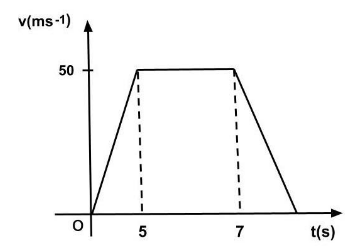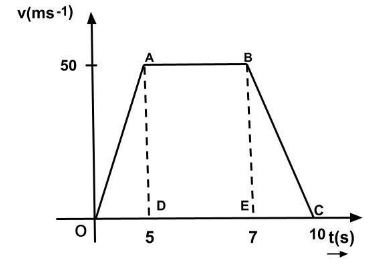Question
Question: A body that starts from rest accelerates uniformly along a straight line at the rate of \[10{\text{ ...
A body that starts from rest accelerates uniformly along a straight line at the rate of 10 ms−2 for 5sec . It moves for 2sec with a uniform velocity of 50 ms−1 . Then it retards uniformly and comes to rest in 3sec . Draw the velocity-time graph of the body and find the total distance travelled by the body.

Solution
The distance travelled is shown by the area under the speed-time graph. For the motion of a particle, distance-time graphs and acceleration-time graphs can be produced, with time always displayed on the horizontal axis. A particle with a constant speed is represented by a straight line on a distance-time graph.
Complete step by step answer:
Let us first write the given values
Acceleration (a)=10ms−2
Time (t) is given as 5sec
Therefore the velocity can be found by using equation of motion that is given by:
v=u+at ⇒v=0+10×5 ⇒v=50ms−1
Now, it moves for 2 seconds with a uniform velocity of 50 ms−1 and finally gets retarded to rest in 3sec.Using the above information we will draw velocity time graph accordingly;

Now, according to the graph: the total distance travelled is (D) = Area under the curve. Therefore,
D=21×(OC+AB)×AD
⇒D=21×(10+2)×50 ⇒D=21×12×50 ∴D=300m
Hence, the total distance travelled by the body is 300m.
Note: It's important to remember that finding the area doesn't fully describe displacement because, being a vector quantity, displacement also requires a direction.Finding the location simply provides a number, not a direction. The magnitude of the displacement, which is equivalent to the distance travelled, is represented by the area under the curve (only for constant acceleration).
